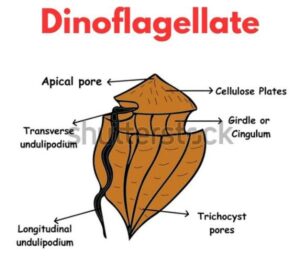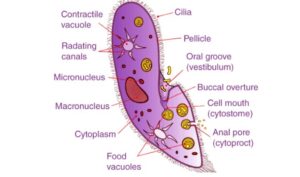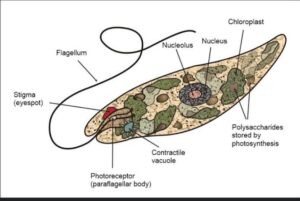Introduction
In biological classification, there have been many attempts to classify living organisms since the dawn of civilisation. Aristotle was the earliest to attempt a more scientific basis for biological classification. He used simple morphological characters to classify plants into trees, shrubs and herbs. He also divided animals into two groups, with RBCs and without RBCs
Two kingdom biological classification system
Given by Linnaeus.
Organisms were divided into two kingdoms plantae and Animals.
Disadvantages:-
This system did not distinguish between eukaryotes and prokaryotes, unicellular and multicellular organism and photosynthetic and non-photosynthetic organisms.
Five Kingdom biological classification system
Given by R.H. Whittaker
All organisms were divided into five kingdoms Monera, Protista, Fungi, Plantae and Animalia.
Fungi were placed in separate kingdom called kingdom fungi.
Five Kingdom biological classification |
| Characters | Monera | Protista | Fungi | Plantae | Animals |
| Cell type | Prokaryotic | Eukaryotic | Eukaryotic | Eukaryotic | Eukaryotic |
| Cell wall | Noncellulosic (Polysaccharide+ amino acid) |
Present in Some |
Present with chitin |
Present (cellulose) |
Absent |
| Nuclear membrane | Absent | Present | Present | Present | Present |
| Body organisation | Cellular | Cellular | Multicellular/ loose tissue |
Tissue/ organ |
Tissue/organ/ organ system |
| Mode of nutrition | Autotrophic (chemosynthetic and photosynthetic) and Heterotrophic (saprophytic/parasitic) |
Autotrophic (Photosynthetic) and Heterotrophic |
Heterotrophic (saprophytic/parasitic) |
Autotrophic Photosynthetic |
Heterotrophic Holozoic/ saprophytic etc. |
KINGDOM MONERA
Sole members of the kingdom are bacteria occur almost everywhere.
Many of them live in or on other organisms as parasites.
They are grouped under four categories based on their shapes,spherical (Coccus), rod shaped (Bacillus), comma shaped (Vibrio) and spiral shaped (Spirilum).
ARCHAEBACTERIA
Are special bacteria since they live in some of the harsh habitats such as extreme salty area (halophiles) hot springs (thermoacidophiles) and marshy areas (methanogens).
Have different cell wall structure than other bacteria. This feature is responsible for their survival in extreme conditions.
Methanogens produce methane and found in gut of ruminant animals.
EUBACTERIA or True bacteria
- Cyanobacteria (Blue green algae)
- May be unicellular, colonial or filamentous, fresh water/marine or terrestrial.
- Have chlorophyll a similar to green plants.
- Can survive without oxygen.
- Completely lack cell wall.
- Are pathogenic to both plants and animals.
KINGDOM PROTISTA
- All single celled eukaryotes are placed in kingdom protista.
- Members are primarily aquatic
- Boundaries of this kingdom are not well defined.
- Reproduce sexually and asexually both.
| Chrysophytes Includes diatoms and golden algae (desmids) Microscopic and floats passively in water currents. Most of them are photosynthetic Cell wall has silica and thus indestructble Body look likes soap box. Form diatomaceous earth. Are chief producers in the oceans. |
Dinoflagellates Mostly marine and photosynthetic. Appear in various colours depending on main pigments present in their walls. Biflagellated. Cell wall has stiff cellulosic plants on the outer surface. Responsible for red tides. Toxins released by organisms may kill other marine animals (fishes) Gonyaulax. |
| Euglenoids Are fresh water forms found in stagnant water. Photosynthetic in presence of sunlight and predators in absence of sunlight. Biflagellated, has one short and one long flagella. Cell wall absent but proteinaceous pellicle present e.g Euglena. |
Simple Moulds Are saprophytic protists. Body moves along decaying twigs and leaves engulfing organic material. Under favourable conditions form plasmodium and under unfavourable conditions they form fruiting bodies. Spores have true walls, resistant to adverse condition and dispersed by air currents. |
ProtozoansIn biological classification are heterotrophs and believed to be primitive relatives of animals Amoeboid:-have pseudopodia for capturing prey. Many have silica shells on their surface. Some are parasites E.g Entamoeba, Amoeba. Flagellated:- have flagella. Parasitic forms many cause disease as sleeping sickness. Eg. Trypanosoma. Ciliated: have cilia, gullet. Eg. Paramoecium Sporozoans: have inflectious spore like stage in their life-cycle. Eg plasmodium
|



KINGDOM FUNGI
- In biological classification of kingdom fungi constitute a unique kingdom of heterotrophic organism.
- show great diversity in morphology and habitat.
- Most of them are saprophytes but they can be parasitic or symbionts such as lichens and mycorrhiza associations.
- Reproduction can take place by vegetative,asexual or sexual means.
- Vegetative reproduction by fragmentation,fission or budding.
- Asexual reproduction by spores formation such as conidia,sporangiospores or zoospores.
- Sexual reproduction involves oospores,ascospres and basidospores formation.
-
The sexual cycle involves three steps of biological classification in kingdom fungi
- 1. Plasmogyamy- fusion of protoplasm between two motile or non motile gamestes
- 2. Karyogamy- fusion of two nuclei.
- 3. Meiosis- in zygote results in haploid spores.
- The morphology of mycelium,mode of sores formation and fruiting bodies from the basis for the division of kingdom fungi into various classes.
KINGDOM PLNATAE
- In biological classification of kingdom plantae includes all eukaryotic chlorophyll containing organism called plants.
- Some are partially heterotrophic such as insectivorous plants like Bladderwort and Venus Fly trap or parasitic as cascuta.
- Life cycle has two distinct phases – diploid sporophytic and haploid gametophytic, phenomenon called alternation of generation.
KINGDOM ANIMALIA
- Biological classification of kingdom animalia includes heterotrophic eukaryotic organisms called animals.
- These are multicellular and lack cell walls.
- Mode of nutrition is holozoic.
- Store food as glycogen or fat.
- Are capable of locomotion.
- Higher forms show elaborate sensory and neuromotor mechanism.
VIRUSES, VIROIDS, PRIONS AND LICHENS
- In biological classificayion, R.H Whittaker’s system, there is no mention of lichens, viruses, viroids and prions.
- Viruses are non- cellular that are characterized by having an inert crstalline structure outside the living cell.
- Viruses contain either RNA or DNA.
- Bacterial viruses usually have dsDNA , viruses that infect plants generally have ssRNA.
- Proteincoat is called capsid made up of capsomeres, which protect the nucleic acid.
- Viruses causes diseasesin animals as well as plants. They cause mumps, small pox, herpes and influenza in animals.
VIROIDS
- Discovered by T.O Deiner.
- Was found to be free RNA, devoid of protein coat, hence named viroids.
- Causes potato spindle tuber disease
PRIONS
- Is abnormally folded protein. Similar in size to viruses. Caues bovine spongiform encephalopathy (BSE) commanly called mad cow disease in cattle and its analoges varient Cr- jacob disease CJD humans.
LICHENS
- Symboitic association between algae and fungi.
- The algal component is phycobiont ( aututrophic) and fungi component is mycobiont (heterotrophic).
- Lichens are good pollution indicators, they do not grow in polluted areas.
Note:-
Earlier biological classification include bacteria, blue green algae, mosses, ferns, gymnosperms, and angiosperms under plants due to presence of cell wall.
In biological classification Chlamydomonas and Spirogyra where placed under algae.
In biological classification of kingdom protista put together Chlamydomonas, Chlorella with Paramoecium and Amoeba.
Quote:- Science without religion is lame, religion without science is blind. ― Albert Einstein
FAQs
Biological classification, also known as taxonomy, is the science of organizing and categorizing living organisms based on shared characteristics and evolutionary relationships.
Biological classification helps scientists study and understand the diversity of life on Earth. It provides a systematic framework for organizing organisms, facilitating communication among scientists, and identifying evolutionary relationships among species.
The system of biological classification was developed by the Swedish botanist Carl Linnaeus in the 18th century. Linnaeus introduced the hierarchical system of classification, including the use of binomial nomenclature (two-part scientific names) to name species.
The major taxonomic ranks, from broadest to most specific, include domain, kingdom, phylum (or division for plants), class, order, family, genus, and species.
Organisms are classified into different taxonomic groups based on their shared characteristics, such as morphology, anatomy, physiology, behavior, and molecular similarities.